Definitions, terminology, specifications, wording, and proper characterizations are all a part of orchid anatomy and terminology. Knowing and understanding how an orchid is structured will better help a person care for their orchid.
In order to properly care for your orchid, it’s important to know what each part of the orchid is and some basic terminology. Plant anatomy, or phytotomy, is divided into four major structures:
1) roots
2) stems
3) leaves
4) all the parts of the reproductive cycle of the orchid.
Below is a list of basic orchid terminology and some pictures to represent each. I’ve tried to keep this more readable and not as boring as reading a dictionary, or an atlas. To do this, I’ve provided a little more information on each topic, which I hope helps. In the end, I added also an orchid glossary of not only the terms and definitions for orchid anatomy, but also terms associated with orchid care.
Let’s start at the flower and work our way down to the roots, but first, we have to know which orchid we are talking about and their differences.
This Article is DOWNLOADABLE and has a VIDEO!
Keep scrolling down to see the video, and at the very end of the article, download your
FREE GLOSSARY or Orchid Terms!
Hint: The glossary also serves a coloring book if your have an iPad and the app Procreate.

Types of Orchids According to Growth
There are two main types of orchids when it comes to growth patterns:
monopodial and sympodial. Monopodial – “Mono” means one, as in contrast to “sym” – which means “together, with, or many.”
Monopodial orchids will have one main flower spike, and growth develops from a basic stem.Phalaenopsis and Vanda orchids are defined as monopodial.
Flowers grow vertically from the middle of this one stem. Actually, all the growth from the monopodial orchid will sprout or emerge from this one stem: the leaves, flower spikes, and roots, too.
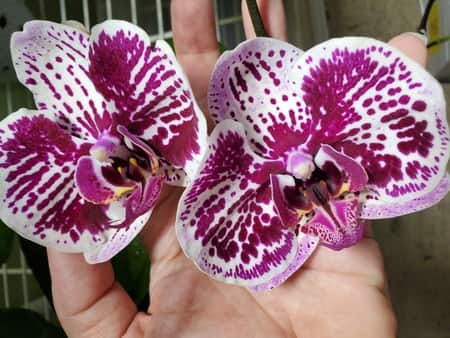
Sympodial orchids will grow horizontally from a tuber called a rhizome. Each new growth will spread outward, not upward. When compared to monopodial orchids, sympodial orchids are wider and appear “fuller” because of this horizontal growth. Growth sprouts from the rhizome, and develops into a stem. Then from the new stem, new leaves, flower spikes, and pseudobulbs develop.
Pseudobulbs are a fleshy storage unit for retaining water and nutrients.
Sympodial orchids include Cattleyas, Oncidiums, and Dendrobiums.
Dendrobiums don’t have the pseudobulb as apparent, and is sometimes referred to as a “cane.”
Practical Differences Between the Two: since monopodial don’t have pseudobulbs, they don’t store water or nutrients. Therefore, they need to be watered more frequently.
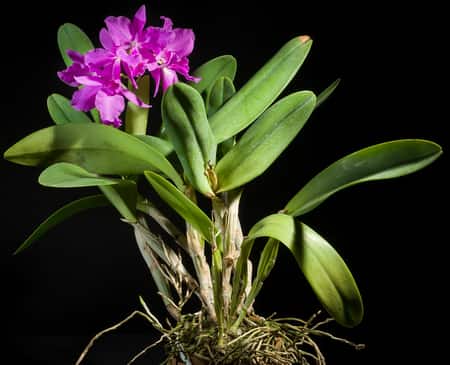
Image Credit: “[Central America] Guarianthe × laelioides ‘Brechts’ CCM/AOS (Lem.) Van den Berg,
Phytotaxa 239: 67 (2015)” by sunoochi is licensed under CC BY 2.0
Orchid Anatomy: All About the Flowers
The flowers are the most beautiful part of the orchid and what make it so distinct. This is our pride and joy as orchid enthusiast. Flowers are the main part of the reproductive system, but aren’t the only ones involved. Sepal, columns, lip, throat, petals… All this together is called inflorescence.
The main stalk, from where the flower spike emerged, is called the peduncle. From each peduncle, lateral stems develop. These lateral flower spikes, called pedicels, will carry the actual blossom.
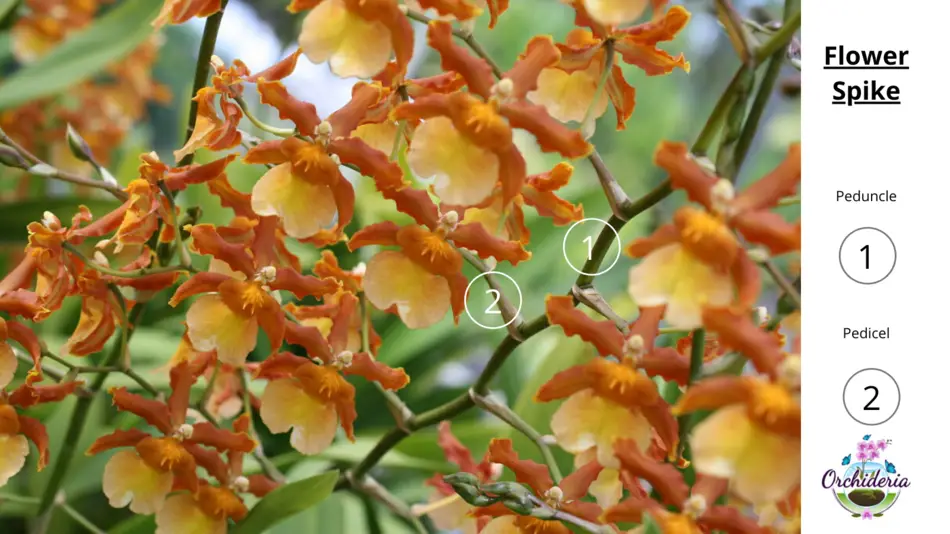
Original picture without the numbers is from “IMG_7044” by rsteele38 is licensed under CC BY-SA 2.0.
The main flower stalk will have some bumpy brownish spots, called nodes. Node are the “signs” or “scars” left on the stalk where flowers once were.
In monopodial orchids, there is only one flower stalk, called raceme, and all buds emerge from it. Translating this with the vocabulary learned above, peduncle is long, but the pedicels are short. This is why it seems like the Phalaenopsis are upright or arched, cascading down with flowers; their penduncles and pedicels favor that formation.
With sympodials, like Cattleyas, the peduncles are not as long, but the pedicels are longer than Phalaenopsis, making the while plant look fuller and rounder.
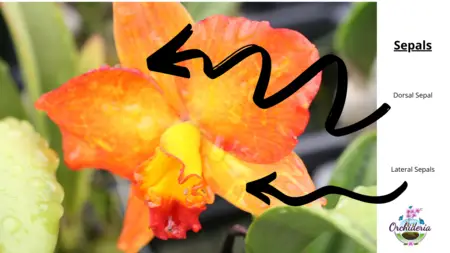
Original picture without the arrows: “IMG_7078” by rsteele38 is licensed under CC BY-SA 2.0
The flower is the reproductive unit of the orchid, attracting both pollinators and orchid collectors.
Petals: Orchids usually have petals that grow in threes. There are the three outer petals and the three inner petals.
Sepal: the outermost petals, which aren’t really petals. If you observe closely, they are shaped differently and not as pretty. This is understandable, since they’re the remains of the flower bud. The larger one, usually towards the back of the flower is called the dorsal sepal. The other two sepals will be lateral, forming a triangle.
The real petals are also developed in threes. The same triangular pattern repeats itself, with two petals out toward the side. Two petals are usually more alike, while the third is larger and more elegantly shaped. This third petal is called the lip or labellum, laying at the base or crown of the flower.
The lip is larger because it is where pollinators will land. Its colors are usually more attractive, calling attention to itself. Flowers in general will accept any pollinator that comes around: bees, flies, butterflies, wasps—anything that flies.
Orchids prefer certain types of insects, and have improved to “seduce” particular insects’ tastes with color, shape, scents and form. Adapting to attract moths, butterflies and smaller birds, orchids have overachieved to maintain their clientele happy.
One of these adaptations is the lip. The function of the lip is providing ample access to pollen, stored in the column, where the reproductive parts of the orchid are. The reproductive parts are called the anther and stigma.
When the orchid is correctly pollinated, it will grow a new plant. But sometimes new orchid “babies” will “hatch” on the sides of stems. These babies are called “Keikis”, which in Hawaiian is translated as, literally, babies. These can be separated from the mother orchid as soon as they develop roots.
Orchid Anatomy Near the Crown
Leaves: Orchid leaves vary in shape, size, form and literally everything that fits into those categories. If the orchid grows one leaf to each side, it is called a unifoliate. Some orchids grow leaves by the pairs, called bifoliates.
To the orchid hobbyist, the main difference is when it comes to repotting. Bifoliates are a bit more demanding, and only like to be repotted when new roots appear. If you repot too early or too late, your orchid will complain.
The leaves are the main form of gas exchange in your orchid. Aerial roots also provide this function, but not as much as the leaves do. On the underside of the leaf, there are small pores, called stomata. These will open during evening and night to release oxygen and take in carbon dioxide—among other gases.
During this process, humidity will be lost, which is why they prefer to “breathe” at night. During lower temperatures, less humidity is exchanged with the gases.
This is why it’s important to never wipe/clean the underside of the leaves. Leave those pretty much alone. If you’d like to dust the topside of the leaves, you can mist them and use a cloth, but never clean the underside of orchid leaves.
In the picture below, can you identify the dorsal sepal, the lateral sepals, the lateral petals, and the lip?
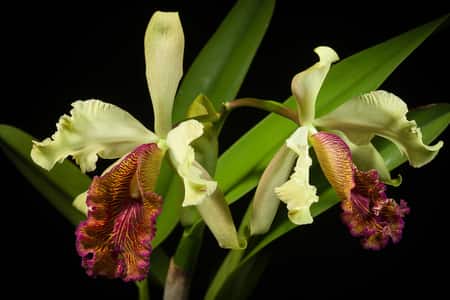
Sheath: A protective layer around new growth that doesn’t develop into a full leaf, but a modified leaf. It is smaller than the inflorescence it’s protecting, and doesn’t develop more than the initial growth spurt. In some orchids, new flower spikes will emerge from under a sheath. A brownish-beige sheath is visible in the lower portion of the picture above.
A cataphyll is a dead sheath that never developed into a leaf. It remains on the orchid as a paper-like layer of protection around the pseudobulb. New flower spikes or leaves, these fragile, tender, and tasty greens are attractive to insects. The cataphyll protects the new growth, providing a physical barrier along with humidity.
Note: When watering, make sure the cataphyll aren’t absorbing or retaining water. It’s common for water to seep into the cataphylls and cause rot or bacterial growth, both which can kill the new stem.
Some orchid growers make a slit in the sheath covering to provide drainage. Once the new stem has developed, the cataphyll turns brown and dies off. You may/can remove these, are there is no longer a function for them.
Pseudobulb: as mentioned before, the pseudobulb is the storage unit for minerals and water in sympodial orchids, like cattleyas, oncidiums, and dendrobiums.
(Note: dendrobium’s pseudobulbs are referred to as “canes”.)
The newer pseudobulbs will emerge, sprouting from the back of your sympodial orchid. These are called “front bulbs” or “lead bulbs.” These are usually larger, more vibrant, and plumper than the other older pseudobulbs. If they’re smaller (as adults) than the previous year’s pseudobulb, then your orchid is suffering.
The older pseudobulbs, planted near the edge of your pot, should not be removed, and are called “back bulbs.” As long as they are green, keep them potted with your sympodial orchid. A leafless pseudobulb still stores energy for the basic maintenance of your plant.
If you decide to transplant/divide the orchid, making two separate pots, keep at least three pseudobulbs together. In some literature, it’s advised to keep up to 5 pseudobulbs for each stand-alone plant.
In the picture below, you can see the pseudobulbs in the background.
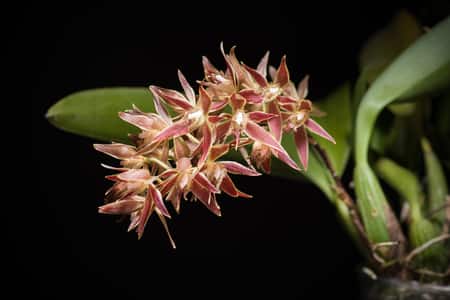
Rhizome: A rhizome is where growth emerges on sympodial orchids. This should never be confused with a root, and should NEVER be potted inside the medium. Keep the rhizome on top the potting medium.
From the rhizome, if you have a sympodial orchid, roots develop and either spread out in the air, or dig deeper into the potting medium. The appearance of new roots is a sure sign to repot.
Both roots, areal and the ones that dive into the potting medium, are covered with velamen. Velamen is a dead layer of protective coating that is spongy. It’s function is to absorb the water and nutrients that are around it, maximizing the root’s source to both.
When watering, you will see the velamen change color. This is due to the chlorophyll inside the paper-thin layer of cells. Aerial roots adapted to collect as much sun as possible, therefore providing more energy to the orchid. If you’d like more about that subject, read this article about aerial roots.
Don’t Stop Learning!
If you want to be included in more information and get a 14-page fertilization guide, please sign up for my newsletter. I don’t spam, but send emails out bi-monthly with some curious topics of interest. If you want more information, click here to go to a specific page on this website where I explain it more in detail.

Also, if you are looking for an orchid journal to keep your notes specifically about orchid care, check out my 2 solutions for that on this page. If note-keeping isn’t your thing, then there is a free excel spreadsheet that you can download. Click here for more information on how to do that.
If you subscribe to my newsletter, I will send you a 14-page guide on the main tips of orchid fertilizer. It is downloadable and you can print it out on your computer. I designed the guide to double up as a coloring book, just to make it fun.
This is a basic overview of the terms you will encounter along the way. As you read more and familiarize yourself with orchids, the easier these terms will be to memorize and identify.
For quick identification, I’ve added the orchid glossary below. If there’s a term below that we’ve not listed above, please tell me and I’ll add it to the list. If you are looking for the downloadable guide, it’s at the very end. 🙂
You’re in Luck! There’s a video about this article! 🙂
To make this video more user-friendly, there are timestamps and chapter titles that will take you to the term you want to know. I follow the same order I did when I wrote this article, so it’s not in alphabetical order. https://www.youtube.com/embed/fAZ7-mSOhnE If you want a quicker way to find the word or term you need, below are all the terms in alphabetical order. Remember, there is a downloadable PDF at the end of this article, so keep scrolling. 🙂
Orchid Care & Potting Medium Glossary
Aerial Roots: Sometimes orchid roots won’t grow down into the potting medium but rather out into the air. These roots are not to be cut off but leave them alone, as they aid in capturing nutrients that float by on air currents. This article explains more about air roots or aerial roots.
Anther: This is one of the reproductive parts of the orchid that holds the pollen. It will be located in the middle of the orchid (called the throat) around the stamen. Some anthers are very pronounced, others are tiny but have a cap covering them.
Anther cap: A covering that protects the anther from various harms: excessive rain, large insects, and others. It will provide extra coverage to protect the pollen.
Back Bulb: Older pseudobulbs that have already grown to mature size, flowered, and now do not use their energy for flowers, but to help nurse the new pseudobulbs that are currently growing. Don’t cut the beck bulbs off your orchid unless you are positive that they are dead. They can be a power supply for orchids for several years, nurturing the newer pseudobulbs.
Bifoliate: Bi means two and foliate comes from the latin, leaf or leafage. Literally, this means a two-leafed orchid, but what it signifies is that the leaves develop in pairs. Phalaenopsis are not bifoliate, since one leaf grows at a time (unifoliate).
Bilateral Symmetry: If you place a mirror down the center of an orchid, you will get the same reflection in the mirror as it is in real life. This symmetry is called bi-lateral, meaning the lateral sides of the image reflected in the mirror imitates the real image. Our faces are also bilateral, which is why some people rationalize the “why” humans are attracted to orchids.
Bloom: The open flower on an orchid.
Bud: The flower has not yet opened and it’s petals and sepals and is still maturing. It’s usually a little “ball-like” structure at the end of the flower spike, a shade lighter than the orchid petals will be. The petal-like structures that form the bud are what later grows to be sepals and sometimes imitates the petals to a perfection. There are always 2 petals, 1 lip, and 3 sepals in an orchid.
Bud Blast: The bud (young, underdeveloped, an immature flower) has not opened yet, but all the sudden stops growing and aborts the mission completely. The buds wither and fall off. This can be caused because of a cold current of air, toxins in the air (paint, hairspray, or others) and underwatering. This article talks specifically about bud blast.
Bracts: a modified leaf or leaves, often very colorful, that grows around flowers or stems in bromeliads.
Canes: Canes are another word for pseudobulbs but more commonly associated with Dendrobiums. For some untechnical reason, we think of pseudobulbs as big, round, plump storage units, but since some orchids have extremely thin pseudobulbs, like Brassavolas, the word pseudobulb doesn’t line up correctly in our brain. So, they were renamed to canes. They are the exact same thing as pseudobulbs, just thinner.
Clone: A clone has the same DNA as the parent plant, in this case, one parent plant. It doesn’t share the combined chromosomes of two plants. In terms of plants, the word clone comes up when a baby plant sprouts out from the side of the mother plant, without fertilization. It will have the exact same characteristics as the mother plant: size, shape, fragrance, and coloring.
Column: Located in the middle of the orchid, this center’s reproductive reference is to both male and female parts in the orchid. Both the place of receiving and giving the pollen sac, the column can be referred to in some literature as the gynostemium. Most household plants do not have this feature, leaving the male and female structures separate. Not all orchids follow this pattern, for example, the Catasetum Orchids don’t. This article explains more about the unique structures of the male and female parts in a Catasetum orchid. All other genera have the male (Stamens) and female (pistil) fused together to form the column.
Deciduous: An orchid that will shed its leave annually is called a deciduous orchid, depending on the time it blooms. Dendrobiums and Catasetums are deciduous and quite frankly, are a bit ugly to look at when all the leaves fall off. The orchid sits there, looking like it’s half asleep, half dead. Deciduous plants need a period of rest to store energy for the next blooming cycle. Whatever you do, don’t throw the orchid away during this period. Phalaenopsis orchids are not deciduous.
Endosperm: The internal part of a seed that provides the nutrition for the new plant until it is mature enough to grow roots and leaves. Orchids do not have this endosperm layer inside the seed, which makes them extremely light. This is important for the seed so it can travel on air currents and reach the nicks and crannies in high trees. That also makes the seed extremely fragile, depending on a fungus called Mycorrhiza (see below) to provide food for it.
Epythitic: Any plant that grows on top of another plant, without having a parasitic relationship to it. The secondary plant is just an anchor or support system, but there is no trade of nutrients between them. This term is used in comparison to household plants that are terrestrial, growing in soil or earth.
Eyes: small “bumps” on the rhizome or stem where new growth could appear. These growth nodes are not developed but can develop when needed, forming new pseudobulbs or flower spikes. This happens because if the developing eye becomes damaged, new growth can emerge from an underdeveloped eye. In monopodial orchids, like Phalaenopsis, eyes are harder to visualize because they are in between the leaf and the stem. Without removing the leaf, it’s almost impossible to see them. Eyes on sympodial orchids are easier to spot since they will be elevated bumps that grow on the side of the rhizome.
Fan: In Phragmipediums and other orchids that do not have a pseudobulb per se, they grow leaves to the sides from a middle stem. This outward growing from a central point forms a type of fan structure.
Front bulb: The newest pseudobulb growth in a sympodial orchid, as compared to older pseudobulbs (or back bulbs). The front bulb is what you need to keep in the middle of the pot when repotting, so the orchid can continue growing toward the other side of the pot. If you place the front bulb facing the side of the pot, the new growth will grow over the rim and down the outside of your pot. Front bulbs are more susceptible to insects and bugs since the plant tissue is tender and filled with nutrients.
Genera: They bigger, broadest category of orchids. Genera examples: Vandas, Phalaenopsis, Phragmipediums, Oncidiums, Cattleyas, and many others. From this division, they separate into smaller categories, called species. Genera is used for the plural, and genus is the singular term.
Genus: The singular term for the word genera.
Hybrid: When one orchid is crossed with two parents that are of different species (sometimes different genera will cross, too, like Cattleyas and Brassavolas). These plants are easier to grow for beginners because they cover more ground in terms of mistakes. This happens because one parent plant could tolerate colder climates while the other parent is a warm-grower, your hybrid will be able to thrive in a wider window of temperatures. This opposite of hybrid is Species, a “pure-breed” so to speak. The species orchids will be very specific and more unforgiving in terms of mistakes.
Inflorescence: Everything that pertains to the flower. This includes the flower stalk, the bud, the peduncle, pedicle, blossom, and all reproductive parts of the plant. This term is important in terms of knowing what potency of fertilizer to use. If the inflorescence is being produced, you’ll need one type of fertilizer, but if the orchid is focusing on roots and leaf production, you’ll need a different fertilizer.
Keiki: A Hawaiian term translated as baby. For orchids, it means a baby orchid or new plant that is growing the side of the stem or pseudobulb. Do not take the keiki off the mother plant until it has three or four good roots and two functional leaves. If the keiki is underdeveloped, it cannot process the nutrients from the sun in a quantity that is sufficient and it will die. Read more about keikis in this article.
Kokedama: A Japanese floral design used with moss and a root ball to form a vase for orchids and other plants. The roots are wrapped around pieces of charcoal and moss is used to cover the roots, forming a cute, compact ball. The vase or pot becomes the moss ball, and this makes a unique and awesome floral design. You can read more about Kokedamas in this step-by-step guide.
Labellum: a petal that has a totally different shape than the other two. The labellum is most often the bottom petal, that opens up to form a landing platform for insects and pollinators. Sometimes the labellum will have a unique color, different than the other two petals. Labellum is also called lip.
Lip: another word for labellum. See above.
Lipophytic: This term describes the nature of the plant, as it likes to cling to rocks, pebbles, or onto cliffs. This is contrasted to epiphytic, growing on the side of tree bark, and terrestrial, that grow near to the surface of the ground on top of leaf litter and moss.
Medium: Whatever your orchid grows in. It can be pebbles, rocks, Styrofoam, bark, perlite, lava rock, charcoal, hydrogel beads (not recommended), and anything else that holds your orchid in the pot. The plural is medium, the singular is media. This article about the correct potting medium for each type of environment is a good place to start.
Meristem: actively growing tissue in plants, usually at the tip of a stem or a root. The meristem is where the undetermined cells haven’t designated what they will be when developed, and it is from these cells that the petri-dish seedlings are formed. This is also the same term in nursing for cells that are used in cloning. When they are new, they haven’t “been assigned” a specific anatomical part, and can be manipulated into growing or maturing into specific cells. This also happens with plants, and the meristem are the “undetermined” younger cells, which will later mature.
Monopodial: a type of orchid that grows vertical instead of horizontal. The long, slender and more compact version of a monopodial orchid grows upright and doesn’t have pseudobulbs or rhizomes. The opposite of a monopodial orchid is the sympodial orchid, like Cattleyas.
Mycorrhiza: the name of the fungus that is needed for orchid seeds to live until they have developed roots and leaves. The symbiotic relationship between the two, orchid seed and fungus, is crucial for the seed to develop and mature into a healthy, adult plant. Without it, the orchid seed wouldn’t be nourished, since it doesn’t have an endosperm that stores food. Mycorrhiza is often used in making new seedlings in petri-dishes, but this is just one method. Just a friendly reminder that not all bacteria or fungus are bad.
Node: Nodes are elevated bumps or notches on the flower spike that serve serval purposes. One is to increase the orchids natural defense system against outside invaders. If bacteria enter through the flower spike, it has a harder time getting past the node. Nodes are also useful to know where to cut the flower spike after your orchids have bloomed.
Osmunda: This is a fiber mat made from coconut hairs. They are very common in potting medium since they absorb a higher quantity of water than most other resources will. Be careful when using osmunda fibers as part of your medium. Recently, most osmunda fibers will have a high salt concentration and residue build-up will become a problem inside your media. The high levels of salt will also cause root burn faster.
Peat Moss: Peat moss is not the same as sphagnum moss. In general, stay away from peat moss. It is ground-up layer of sphagnum moss that covers the forest floors. Yet, it’s not only sphagnum. It will have branches, old leaves, dead bugs, and everything else that falls onto that layer of moss before it’s ground up into a fine powder. The only time you should be using peat moss is to make a fake background for your terrarium, because it fixates well to the glue making interesting arrangements.
Pedicle: Part of the inflorescence that attaches the individual flower to the flower spike.
Peduncle: Part of the Inflorescence that attaches the branch of various blossoms to the flower spike. One peduncle can hold several pedicles on it.
Peloric: The norm for orchids is to have three back sepals (which are the bud’s old petals), 2 petals, and 1 lip. Sometimes when the orchid gets a little confused during its formation, it can develop a lip that looks like a petal, or a petal that looks like a lip. This is called a peloric orchid. There is more information about peloric orchids in this article.
Perlite: A type of potting medium that looks like rough Styrofoam balls. Since it is non-organic material that won’t decay over time, it makes for a great addition in your orchid media by creating air pockets to amplify airflow. Perlite is a volcanic glass that was heated to 1600° F (871° C) and because of it’s rough, porous surface, orchid roots attach well.
Pollinia: The collective pollen grains that hold together as a unit. Pollinia can be found in the anther of the orchid. Pollinia is the plural form of pollinium.
Pseudobulb: The storage unit of the orchid, usually enlarged and thicker than the rest of the stem. Only sympodial orchids have pseudobulbs, like Cattleyas, Oncidium, and Cymbidiums. Phalaenopsis do not have Pseudobulbs. Pseudobulbs are a sign that the orchid might live in a habitat where during some part of the year, the climate may not provide all the nutrients or water it needs, so the orchid adapted and produced its own “basement of extra supplies”.
Resupination: This term applies to the turning movement in lip/labellum to its place. While inside the bud and still forming, the lip is actually on the top. It turns, or resupinates, moving to the bottom of the blossom. In female Catasetum orchids, the bottom lip actually doesn’t turn as it should and forms a hood or cape which covers the flower. This lack of turning is called non-resupination. It comes from the Latin, supine, or “on your back” which is a term also used in nursing/health care.
Rhizome: The rhizome is a stem that is laid horizontally, and its growth is always out laterally instead of upward. This makes a bushier plant that occupies larger width pots. From the rhizome, the roots, eyes, pseudobulbs, and new growth appear. Monopodial orchids like Phalaenopsis do not have a rhizome.
Sepal: A sepal is one of the structures that looks a lot like a petal, but isn’t. If you look closely at the orchid, you’ll see three outer petals that used to be the bud. These sometimes mimic the same structure as the petals, but they really aren’t. Each orchid has 3 sepals, 2 petals, and 1 lip.
Sheath: A sheath is a protective covering that envelops a new flower. Not all orchids have sheaths, but the best example is a Cattleya orchid. Before the bud opens, it is sensitive to temperature changes, loss or increase in humidity, and light. The orchid needs to protect this new flower so it develops what looks like a malnourished protective coat. Sheaths don’t always cover flowers, they can protect new leaves, too.
Sphagnum Moss: A type of moss that works best for orchid cultivation in pots. It is highly absorptive, which makes the water-retention linger longer in the pot. There is an entire article just about sphagnum moss here, where I talk about the 10 reasons why it’s a good idea to use sphagnum moss.
Spanish Moss: Used a decorative layer of moss in floral decorations, Spanish moss is not as water retentive as sphagnum moss. It will dry out faster and is not appropriate to use in the potting media. Some orchid enthusiasts use Spanish moss as a top layer, to retain humidity from the air longer around aerial roots.
Spike: This is sometimes confused as a new root when it first appears on a Phalaenopsis orchid, but it will produce flowers and not roots. The flower spike will emerge from the sides of the leaf and have triangular, hard notches at the end, which don’t turn greener or whiter when watered. Their color remains the same. A new root will have a rounded end and eventually point down to the potting media or out to the side. A flower spike will naturally grow toward the light source.
Stamen: the female part of the flower, similar terminology to the stigma.
Stake: A guide that can be bamboo or metal that you insert in the potting medium to stabilize the orchid. This is necessary when orchids become top-heavy or tend to lean to one side. It is also done when the orchid has a flower spike, inducing the spike to grow and curve the way you’d like it to.
Stem: This is the equivalent to the rhizome in a sympodial orchid, but in a monopodial orchidlike Phalaenopsis, the stem is where all life from the orchid will emerge. You can grow back an orchid with no leaves, or one with no roots, but it’s almost impossible to bring back an orchid with stem rot, or that has had damage done to the stem.
Stigma: The female counterpart of the flower, receives the pollen and prepares it into a seed pod. Also called the pistil.
Stomata: This is the breathing mechanism of the orchid found mainly in the leaves. They are sometimes referred to as pores. There are more stomata on the underside of the leaf, where gas transfers occur during the night, expelling the gases that orchids don’t need and absorbing gases in the environment they need for consumption. If there isn’t enough humidity in the air, the stomata remained closed and there is no gas exchange. This causes toxic build-up in the leaves.
Stigmatic Surface: This is the female counterpart of the orchid and refers to the entire surface where pollinia can be attached. It can have a special sap to it, while other orchids don’t.
Sympodial: “Sym” means many, as this refers to the many “stems” or “pseudobulbs” these orchids have. Sympodial orchids have a rhizome which all the new pseudobulbs and roots grow from. This rhizome sits above the potting media and grows out horizontally, covering more ground across the pot. This makes for a shorter and bushier plant than compared to the long slender Phalaenopsis orchids, which isn’t a sympodial orchid. The contrary of sympodial is monopodial, like Phalaenopsis and Vanda orchids, which grow vertically instead of horizontally.
Throat: The throat is a general term used to identify everything leading from the lip of the orchid to the middle portion where the reproductive organs are found. It isn’t a technical term, just a generalization, meaning the center portion near the middle of the orchid’s lower petal, named labellum. From the landing platform which the lip provides, the pollinator heads toward the throat of the orchid to get pollen.
Transpiration: This is a process where water droplets escape the pores of the orchid, called stomata. If this process is done more rapidly than the orchid absorbs water, than dehydration sets in. If the orchid is waterlogged and absorbed more water than it can transpire, than the leaves puff up and the outer cells die, a process called edema.
Unifoliate: “Uni” means one, and foliate means leaf. In essence, this means a one-leafed plant, but what it’s really talking about is there is only one leaf per pseudobulb. Cattleyas are both unifoliate and bifoliate, depending on their species. The care for both unifoliate and bifoliate plants is the same.
Velamen: This is an outer protective coating of the orchid root, maximizing the surface area where roots can absorb water and nutrients. The actual root is a string-like structure, that is very tiny. The velamen is a thin layer around that root, practically duplicating the surface area it has to capture nutrients that come floating by in the wind. The velamen’s color is how I determine whether or not it’s time to water again. If the velamen is green, leave the orchid alone. If the velamen is silvery-gray, it’s time to water.
Resources:
The articles below do not stay on my website, but direct you to other good resources. It’s always important to read other’s opinions and compare notes.
Orchid Plant Parts and Why they Matter , written by Sue Bottom
, written by Sue Bottom
Orchid Morphological Features , which is the dictionary explanation of orchid anatomy.
, which is the dictionary explanation of orchid anatomy.
I’ve hoped this helped with your knowledge about orchids.
This Article is DOWNLOADABLE!
Download Orchid Glossary in PDF
Finally, Your FREE GLOSSARY or Orchid Terms!
I made this guide in PROCREATE (You can get this app for about 5 dollars in the App Store). If you have an Ipad (Affiliate Link ) and an Apple Pencil (Affiliate Link
) and an Apple Pencil (Affiliate Link ), then this guide turns into a coloring book, too. You can’t beat that!
), then this guide turns into a coloring book, too. You can’t beat that!
If you don’t have either of those, you can still view it in a PDF or print it off as a coloring book. Wish you all the best in orchid care!
Happy Cultivating!


Thank you for your thoroughness and detail. And that glossary!